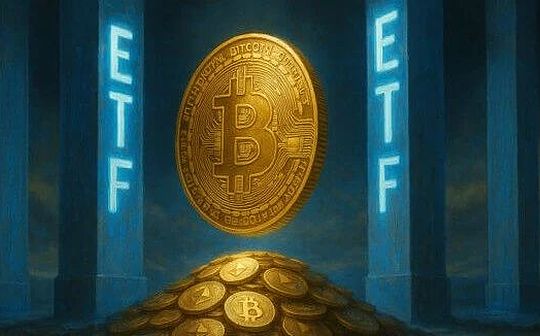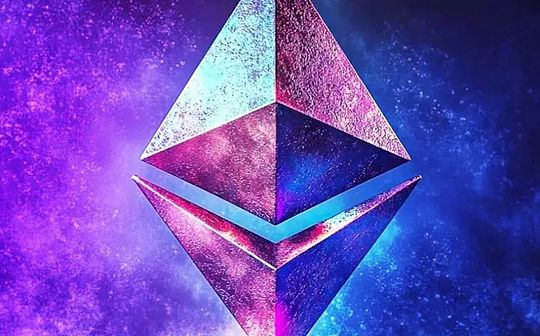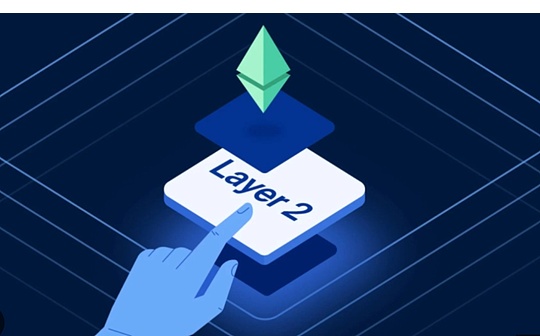
Author: YBB Capital Researcher Ac-Core; Compilation: Block Rhythm
Eclipse founder Neel Somani, who worked as a software engineer at Airbnb and a quantitative researcher at Citadel, founded the Solana-based startup Eclipse in 2022 and was supported by Solana Anatoly Yakovenko and Polygon, among others/organizations (for Solana and PolygonBuild a compatible Rollup blockchain).
According to CoinDesk on September 28, 2022, Eclipse successfully completed a $6 million Pre-Seed round led by Polychain and a $9 million seed round led by Tribe Capital and Tabiya, with a total financing of 1,500 yuanTen thousand dollars.In addition, Eclipse received a development grant from the Solana Foundation to support Solana Virtual Machine-powered Rollup.
Eclipse founder Somani uses his connections and geographical advantages to the Solana Chicago headquarters to successfully create a unique chain using Solana’s virtual machines.Its vision is to enable developers to deploy Rollup powered by Solana virtual machines, with plans to launch a public test network on the Cosmos ecosystem in early 2023, and a Move language intended to support Aptos in the future.
“Eclipse paves the way for Solana to communicate with Cosmos through Inter-Blockchain Communications (IBC).” commented Anatoly Yakovenko, Solana and Eclipse angel investor.
“As large enterprises and governments begin to enter the blockchain space, Eclipse is an important infrastructure to promote their use cases such as Web2-scale consumer and financial applications,” commented Niraj Pant, partner at Polychain Capital.
Eclipse architecture
According to the official explanation, Eclipse Mainnet is Ethereum’s first universal L2 built around SVM. It combines the best of the modular stack and aims to be the fastest and universal Layer2 for Ethereum powered by SVM.The project architecture is to use Ethereum as the settlement layer and use it for the official embedded verification bridge; Celestia as the data availability layer; RISC Zero is used to generate zero-knowledge fraud proofs; and ultimately, the modular Layer2 project that uses Solana’s SVM as a whole to execute.The following will be explained in detail based on the official explanation.
Settlement Layer—Ethereum: Eclipse will settle to Ethereum (i.e., the embedded verification bridge on Ethereum), and use ETH as its Gas consumption, and fraud proofs will also be submitted on Ethereum;
Execution Layer—Solana Virtual Machine (SVM): Eclipse takes a high-performance SVM as its execution environment, i.e. the Solana Labs client (v1.17);
Data Availability Layer—Celestia: Eclipse will publish data to Celestia to achieve scalable data availability (DA);
Proof mechanism—RISC Zero: Eclipse will use RISC Zero for ZK fraud proof (no intermediate state serialization is required);
Communication Protocol—IBC: Bridges with non-Eclipse chains through Cosmos’ inter-chain communication standard IBC;
Cross-chain protocol—Hyperlane: Eclipse and Hyperlane collaborate to introduce Hyperlane’s permissionless interoperability solution to a blockchain based on Solana virtual machine (SVM).
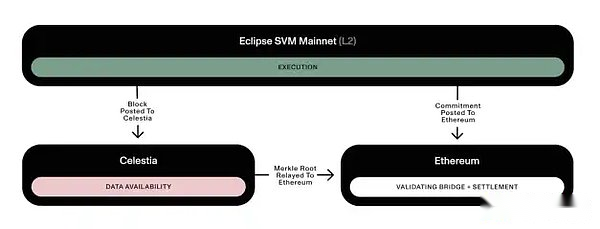
Source: Eclipse Official
Settlement layer: Obtain Ethereum’s security and liquidity
Eclipse uses Ethereum as the settlement layer like other Ethereum Rollups. This process requires the verification bridge of Eclipse on Ethereum to be directly included in Eclipse. Its nodes need to detect the correctness of the verification bridge and correct transaction sorting to allow users toGet Ethereum level security.
L2BEAT defines Layer2 as “a chain that fully or partially obtains its security from the first layer of Ethereum so that users do not have to rely on the integrity of Layer2 validators to ensure the security of funds.”Eclipse Verification Bridges can perform final validity and censorship resistance in certain failure situations, and users can use the bridge to force their transactions to complete even if the sorter goes down or the review begins in L2 and use Ethereum as a transaction GasCarry out combustion.
Execution layer: Get Solana’s transaction speed and scale effect
To improve efficiency, Eclipse Mainnet adopts Solana’s execution environment, using SVM and Sealevel (Solana is used to build scale-out technology solutions, and the hyperparallel transaction processing engine is used to scale horizontally across GPUs and SSDs), which is in line with EVM single-threadedCompared with the operation of the operation, the advantage is that it can be executed without designing overlapping state transactions, rather than in sequence.
Regarding EVM compatibility issues, Eclipse Mainnet partnered with Neon EVM to allow developers to leverage Ethereum tools and build Web3 applications on Solana, with a throughput of up to 140TPS than single-threaded EVMs, according to official data.EVM users interact natively with applications in Eclipse Mainnet through the “Snaps” plug-in of the MetaMask wallet.
Data Availability: Bandwidth and Verified Properties with Celestia
Ecilpse Mainnet will leverage Celestia to achieve data availability and achieve long-term partnerships because Ethereum is currently unable to spend Ecilpse’s target throughput and expenses, even after EIP-4844 upgrades, it can provide an average of about 0.375 MB per block.Blobs space (the limit per block is approximately 0.75 MB).
According to official data, the ERC-20 transaction based on Rollup expansion is calculated at 154 bytes per transaction, which is equivalent to the sum of all Rollups about 213TPS, while for Compression Swap, the TPS of all Rollups is calculated at about 400 bytes per transaction.It is about 82TPS.Blobstream is expected to increase to 8MB after the network proves stable and more DAS (see below for explanation of related extensions) light nodes up and down compared to the 2MB block launched by Celestia.
Ecilpse believes that with the support of Celestia’s DAS light nodes, Celestia has become the best choice for Eclipse Mainnet today in view of the trade-off between security of the crypto economy and highly scalable DA throughput.Even if there is a view that using Ethereum DA is the orthodox Layer2, the project party will continue to pay attention to the progress of EIP-4844 in DA expansion. If Ethereum can provide Eclipse with a larger scale and high throughput DA, it willReassess the possibility of migration to Ethereum DA.
Proof mechanism: RISC Zero fraud proof (no intermediate state serialization)
Eclipse’s proof method is similar to Anatoly’s SVM fraud proof SIMD (see GitHub extension link 2 for details), which is consistent with John Adler’s insight to avoid the high cost of state serialization.So to avoid reintroducing the Merkle tree (hash tree) into SVM, early project parties tried to insert Sparse Merkle Tree in SVM, but every transaction update to the Merkle tree will have a huge impact on performance.Without using Merkel trees for proofing, existing general Rollup frameworks (such as OP stacks) cannot be used as the basis for SVM Rollup, which requires a more creative proof of failure architecture.
Proof of Fault Requirements: The input commitment of the transaction, the transaction itself, and the proof that the transaction will be different from the output specified on the chain.
The input commitment is usually implemented by providing the Merkle root of the Rollup state tree. Eclipsse’s executor publishes a list of inputs and outputs for each transaction (including account hash values and related global states), and generates a transaction index for each input, andPost the transaction to Celestia so that any full node can follow up, extract the input account from its own state, calculate the output account, and confirm that the promises on Ethereum are correct.
There are also two possible major error types here:
Incorrect output: The verifier provides ZK proof on the correct output chain.Eclipse uses RISC Zero to create ZK proofs for SVM execution, which continues the project’s previous work of proofing BPF bytecode execution (see GitHub extension link 3 for details).This allows our settlement contracts to ensure correctness without having to run transactions on the chain.
Incorrect input: The verifier publishes historical data on the chain, indicating that the input status does not match the claimed one.Then, Celestia’s Quantum Gravity Bridge is used to allow Eclipse settlement contracts to verify fraudulent behavior in historical data.
Eclipse connections to ETH and Celestia
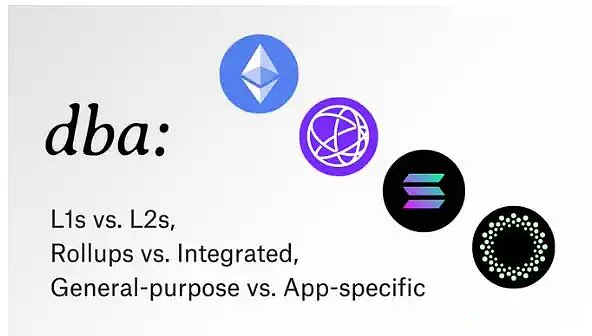
Source: @jon_charb
DA is one of the main parts of Rollup’s cost expenditure. Currently, there are two main methods for data availability of Ethereum L2, Calldata and DAC (Data Availability Committees).
Calldata: For example, Layer2 solutions such as Arbitrum or Optimism directly publish transaction data as calldata to Ethereum’s highly censored blocks.Ethereum will set the call data and compute and storage in one unit: Gas, which is also one of the main costs Rollup spends on Ethereum.To improve efficiency EIP-4844 upgrade, Blobspace is introduced to replace calldata, providing a target value of 375 KB per block for all Rollups;
DAC: DAC has a much higher throughput than publishing calldata directly on-chain, but users need to trust a small committee or group of validators to avoid malicious data hierarchy.DACs, including restaking-based solutions, introduce significant trust assumptions to L2s, forcing DACs to rely on reputation, governance mechanisms, or token voting to curb or punish data concealment, so to some extentDAC is required when using external DA.
It should be added that Celestia was used in Eclipse to allow Layer2 to access Celestia’s blobspace, which is approximately equivalent to 9,000 to 30,000 ERC-20 transmissions per second.However, Layer2, which uses Blobstream during the process, will rely on the Celestia verifier proof. If the security process light node detects 2/3 of the Celestia verifiers that retain data, they can be punished. Objectively speaking, DAC and native chain DAThere is still insufficient trust in comparison, but it is inevitable to think about this deficiency from the perspective of innovation and market narrative.
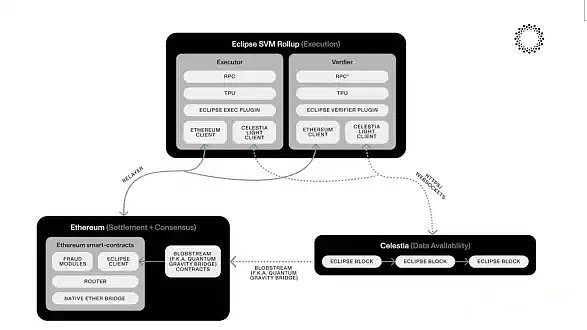
Source: Eclipse Official – Eclipse Modular Interaction Logic
According to the official documentation, as shown in the figure above, Eclipse proved to Ethereum through Celestia’s Blobstream (as described above for Ethereum modular DA solution based on DAS extension), Eclipse data proved to Ethereum has been tested and run, allowing the bridge to be based on Celestia’sSign up the data root to verify the data security provided for fraud proof.Its users deposit funds into Eclipse through the native Ethereum bridge, and the process is summarized as follows:
1. The user calls the Eclipse deposit bridge contract on Ethereum (see Extended Link 1 for the contract address);
2.Eclipse In the SVM executor (calculates the SVM result and outputs it to the Ecilpse new status node), the repeater (ETH and Eclipse channel) completes the user’s sending address and receiving address cross-chain data interaction;
3. The repeater calls the SVM bridge program, which is responsible for sending user deposits to the target address;
4. The repeater verifies the deposit transaction through the zk-light client (to be implemented);
5. The final transfer transaction block containing subsequent deposits is completed and published through the Solana Geyser plug-in.
In this process, the SVM executor is published through Geyser to the message queue, and its slot is published to Celestia as a data block, and Celestia’s validator undertakes the submitted data blocks forProof transactions are included in the Eclipse chain and correspond to the data root, and finally each Celestia data block is relayed through the Blobstream to the Eclipse bridge contract on Ethereum.
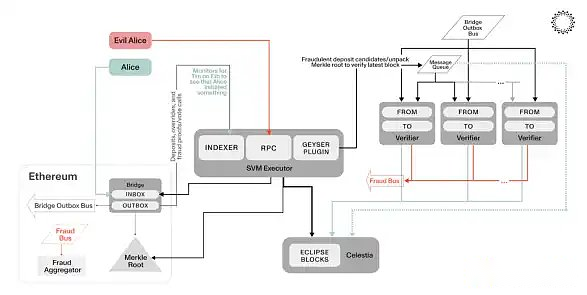
Source: Eclipse Official: Celestia and SVM executor interaction
At the same time, similar to Ethereum’s other Layer2 that uses fraudulent proofs, withdrawing funds between Eclipse and Ethereum also requires a window period to challenge, so that validators can submit fraudulent proofs when the state transition is invalid.
-SVM executors regularly publish an epoch of the Eclipse slot (processes in predetermined batch counts) to Ethereum and issue collateral;
-Eclipse’s bridging contract performs basic inspection to ensure that the published data format is intact (see the reference article [2] Fraud Proof Design Chapter);
– If the submitted batch passes the basic check, a predefined window will be generated. In this window, if the batch is committed, it means that the state transition is invalid, and the verifier can issue a fraud certificate;
-If the validators successfully issue a fraud certificate, they win the executor’s guarantee, the batch released is denied, and the specification state of Eclipse L2 rolls back to the last valid batch commitment.The administrators of this Eclipse will have the right to select new executors;
-But if the challenge period is passed without the fraud proof, the executor will recover his collateral and reward;
– Finally, the Eclipse bridge contract completes all withdrawal transactions included in the final batch.
summary
Eclipse is still in the early stage of developing test networks, and is the first SVM Layer2 on Ethereum. The test network is currently online and the main network is scheduled to be released in the Q1 quarter of 2024.Ethereum is still the development route that regards Rollup as its core. Putting aside the orthodox topic, this means to a certain extent that Ethereum has handed over the broad definition of Layer2 to the market, so open empowerment also hiding.Competition in various forms.It is precisely because Eclipse uses modular development to combine Ethereum security, Solana’s high performance and Celestia DA to conduct a strong market narrative.
Looking back at the development process of Ethereum, a very interesting point is that the last round of market conditions was that under the hype of DeFi Summer, a large number of innovations and additions of “DeFi dolls” and “DeFi Lego” have emerged, which has led to a blowout development of the entire ecosystem.In this round, a large number of “pending dolls” and “pending LEGO” combinations appeared in the combination of LSD and Re-staking, allowing EigenLayer, Blast and Merlin of the BTC ecosystem to hit TVL in the short term.If nesting dolls and LEGOs are regarded as the main themes of market sentiment, modularity can also play their own nesting dolls and LEGO melodies in the future.
The charm of modularity lies in the decoupling benefits of components, so that every layer of innovation in the stack can amplify the optimization of other modules. Perhaps in the future, for developers and users, modularity will beThe development process may generate a large number of competitive options.


